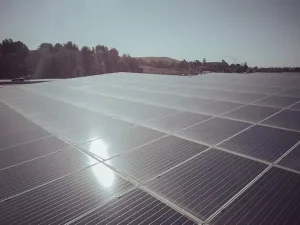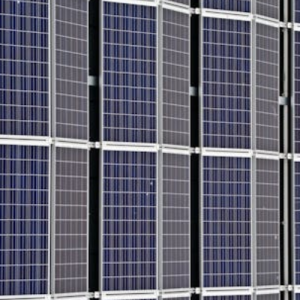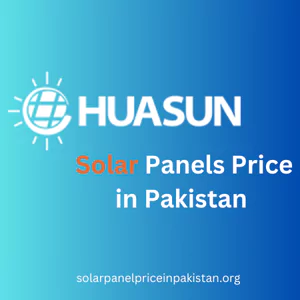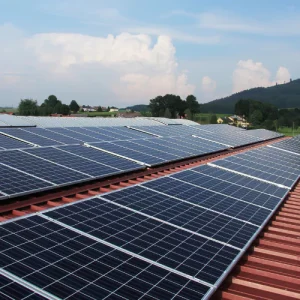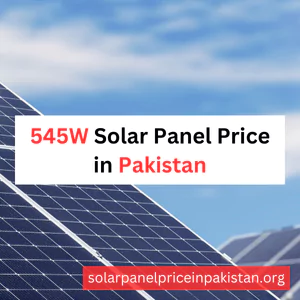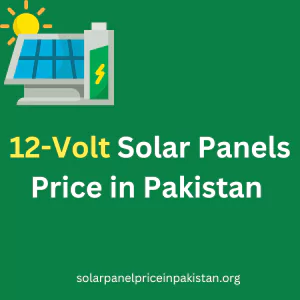Types of Solar Panels in Pakistan 2024
Solar energy is becoming an increasingly popular alternative energy source in Pakistan due to the country’s abundant sunlight and the growing demand for sustainable power solutions. Various types of solar panels are available in the market, each with distinct features, advantages, and disadvantages. This article explores the main types of solar panels used in Pakistan and their respective benefits.
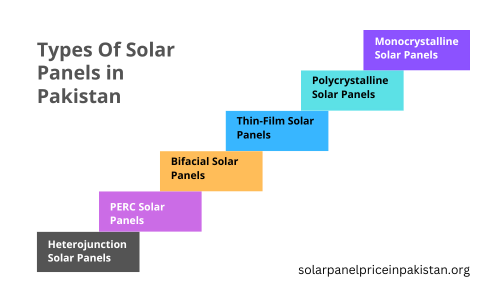
Monocrystalline Solar Panels
Monocrystalline solar panels are made from a single continuous crystal structure. These panels are easily recognizable by their uniform dark appearance and rounded edges.
Advantages
- High Efficiency: Monocrystalline panels typically offer the highest efficiency rates, often exceeding 20%.
- Space Efficiency: They require less space compared to other types of solar panels to produce the same amount of energy.
- Longevity: These panels have a long lifespan, often coming with warranties of up to 25 years.
Disadvantages
- Cost: They are more expensive to produce and purchase compared to other types of solar panels.
- Performance in Shade: Performance can be significantly reduced if even a small part of the panel is shaded.
Polycrystalline Solar Panels
Polycrystalline solar panels are made from silicon crystals that are melted together. They have a bluish hue and a square shape, with a less uniform appearance compared to monocrystalline panels.
Advantages
- Cost-Effective: Polycrystalline panels are generally cheaper to produce, making them more affordable for consumers.
- Efficiency: While less efficient than monocrystalline panels, they still offer a decent efficiency rate, typically around 15-17%.
Disadvantages
- Space Requirements: They require more space to produce the same amount of energy as monocrystalline panels.
- Temperature Sensitivity: These panels are more sensitive to high temperatures, which can reduce their efficiency slightly.
Thin-Film Solar Panels
Thin-film solar panels are made by depositing one or more layers of photovoltaic material onto a substrate. These panels are flexible and lightweight, making them versatile for various applications.
Advantages
- Flexibility: Their lightweight and flexible nature makes them ideal for unconventional installations, such as on curved surfaces.
- Temperature Performance: They perform better in high temperatures and low-light conditions compared to crystalline panels.
- Cost: Thin-film panels are typically cheaper to manufacture.
Disadvantages
- Lower Efficiency: They generally have lower efficiency rates, around 10-12%.
- More Space Required: Due to their lower efficiency, more space is needed to install a system that generates the same amount of power as crystalline panels.
- Shorter Lifespan: They usually have a shorter lifespan and warranties compared to monocrystalline and polycrystalline panels.
Bifacial Solar Panels
Bifacial solar panels can capture sunlight from both the front and back sides. They are usually made from monocrystalline or polycrystalline cells and can be installed in a way that maximizes their exposure to sunlight from various angles.
Advantages
- Increased Energy Production: By capturing sunlight from both sides, they can generate more electricity than traditional single-faced panels.
- Durability: They often come with robust construction and long warranties.
Disadvantages
- Cost: They are typically more expensive than traditional single-sided panels.
- Installation Complexity: Requires careful planning and specific installation setups to maximize their bifacial capabilities.
PERC (Passivated Emitter Rear Cell) Solar Panels
PERC solar panels incorporate an additional layer on the back of traditional monocrystalline or polycrystalline cells, enhancing their efficiency by reflecting unused light back into the cell for a second chance at absorption.
Advantages
- Higher Efficiency: PERC technology boosts efficiency by 1-2% compared to standard cells.
- Better Performance in Low Light: They perform well in low-light conditions and high temperatures.
- Cost-Effective: The increase in efficiency often outweighs the marginal cost increase.
Disadvantages
- Degradation: Potential for slightly higher degradation rates over time compared to traditional panels.
Heterojunction Solar Panels
Heterojunction solar panels combine layers of crystalline silicon and amorphous silicon to create cells that are highly efficient and stable.
Advantages
- High Efficiency: These panels offer some of the highest efficiency rates in the market.
- Temperature Coefficient: They have a lower temperature coefficient, meaning they lose less efficiency in high temperatures.
- Durability: They tend to have longer lifespans and better performance warranties.
Disadvantages
- Cost: Heterojunction panels are among the most expensive due to their advanced technology and manufacturing process.
Conclusion
Pakistan’s solar panel market offers a variety of options to cater to different energy needs, budgets, and installation environments. Monocrystalline panels are ideal for those seeking high efficiency and longevity, while polycrystalline panels provide a more cost-effective solution. Thin-film panels offer versatility and are better suited for non-traditional installations, and bifacial panels present an innovative approach to maximize energy production.
PERC and heterojunction panels offer advanced technologies that enhance efficiency and performance. As solar technology continues to advance, the adoption of these panels will likely grow, contributing significantly to Pakistan’s renewable energy landscape.
Also Check:
